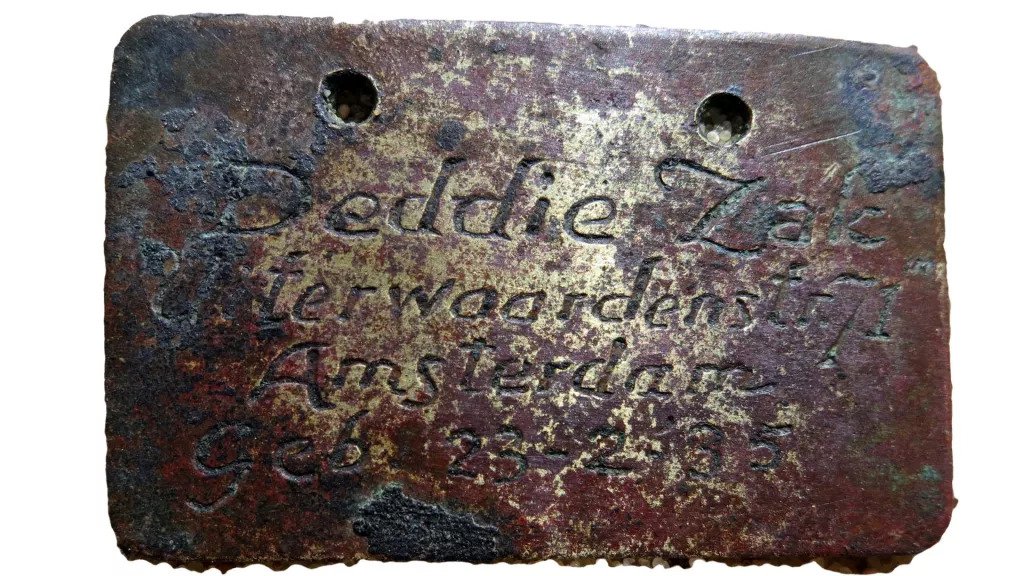Children’s ID tags unearthed at Nazi death camp in Poland
I.D. was found by archaeologists excavating the Sobibor extermination camp in Poland. The Yeshiva World notes the tags containing the names of four Jewish children from Amsterdam aged 5 to 11 who were sent to their deaths during the Second World War.
Yoram Haimi, an archaeologist at the Israel Antiquities Authority (IAA) who helped lead the dig, notes that the tags included the children’s birthdates and hometowns.
“Since the tags are very different from each other, it is evident that this was probably not some organized effort,” he says in a statement. “The children’s identity tags were prepared by their parents, who were probably desperate to ensure that the children’s relatives could be located in the chaos of the Second World War.”

More than 70 years after the children’s murders, researchers were able to connect the tags to information kept at a memorial centre at the Westerbork transit camp in the Netherlands.
“I’ve been digging at Sobibor for 10 years,” Haimi tells Israel Hayom’s Yori Yalon. “This was the most difficult day. We called the centre and gave them the names. They sent pictures of young, smiling kids to our phones. The hardest thing is to hear that one of the kids [whose] tag you’re holding in [your] hand arrived at Sobibor on a train full of children ages 4 to 8, who were sent here to die alone.”
As Patrick Pester reports for Live Science, the team was able to trace all of the children through train records. Some were part of mass deportation of 1,300 small children who were sent to the gas chambers as soon as they arrived at the camp.
The archaeologists found the tag of 6-year-old Lea Judith De La Penha, who was killed in 1943, near the camp’s railway platform. They discovered the other three tags—belonging to 6-year-old Deddie Zak, 11-year-old David Juda Van der Velde and 12-year-old Annie Kapper—in the camp’s “killing area,” which housed a gas chamber, crematorium and mass grave, per Live Science. Only half of Van der Velde’s partially burned tag was found.

“The Germans burned his body and on his neck was this tag,” Haimi tells Live Science.
According to the United States Holocaust Memorial Museum’s Holocaust Encyclopedia, Nazi authorities built Sobibor in the spring of 1942. It was the second of three killing centres—along with Belzec and Treblinka—that was part of Operation Reinhard, a plan to murder Jews living in the part of Nazi-occupied Europe known as the General Government.
Most of the camp personnel came from Operation T4, the Nazi’s first mass murder program, which targeted people with disabilities. The Operation Reinhard camps channelled carbon monoxide generated by large motor engines to fill gas chambers.
Ongoing excavations at Sobibor also revealed the camp’s gas chamber, a 3,700-square-foot building with eight rooms.

“We can say that every time you can put between 800 to 900 people in this gas chamber, turn on the motor of the tank and kill in 10 minutes 900 people,” Haimi tells Live Science. “It’s a factory of killing.”
Yad Vashem, Israel’s official Holocaust remembrance memorial, estimates the number of people murdered at Sobibor around 250,000. But Hami says the real number is likely higher.
“We will never know how many Jewish people [were] killed in this camp,” he tells Live Science. “I can tell you from the size of the mass graves—because they are huge—it must be much more than 250,000.”
Ofer Aderet of Haaretz reports that Haimi began excavating the site in 2007 as a “private undertaking.” He’s now working with Polish colleague Wojtek Mazurek and others to continue uncovering artefacts.
The team recently discovered several I.D. tags that identified some of the camp’s victims as North African Jews. Other discoveries include pins worn by the right-wing Jewish group Beitar, as well as jewellery, keys, shoes and other personal items owned by those killed at the camp.
Haimi tells Haaretz that he has also discovered a “huge number of alcohol bottles” apparently belonging to Nazis and other camp personnel. The archaeologists gave the items to a museum at the camp that opened last year but is currently closed due to the pandemic.
Sobibor remained in operation until October 1943, when prisoners staged an uprising. Around half of the 600 people then held at the camp escaped, but many were subsequently killed. About 50 former prisoners from the camp survived the war. After the uprising, the Nazis shut the centre down, shooting all prisoners who hadn’t managed to flee.
